High Impact Tutoring Built By Math Experts
Personalized standards-aligned one-on-one math tutoring for schools and districts
In order to access this I need to be confident with:
Prime and composite numbers Even numbers Exponents Dividing multi-digit numbersPrime factors
Here is everything you need to know about prime factors. You will learn the fundamental theorem of arithmetic, how to express a number as a product of prime factors and use the product of prime factors to recognize special numbers such as square numbers and cube numbers.
What are prime factors?
Prime factors are prime numbers that are factors of another number.
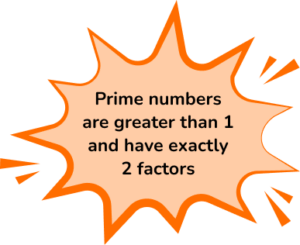
A composite number is the product of two or more factors. All of these types of numbers are integers (whole numbers).
For example,

In number theory, the Fundamental Theorem of Arithmetic states that every integer greater than one is a prime number or can be represented by a product of prime numbers.
For example,

This would mean that the number \bf{240} is a composite number with the prime factors of \bf{2, 3} and \bf{5} .
Expressing a composite number as a product of prime factors can be utilized for a wide variety of problems such as:
- calculating the greatest common factor (GCF)
- calculating the least common multiple (LCM)
- simplifying square roots (radicals)
- determining whether a number is a square number or cube number
- factorization
- calculating the square roots of numbers
and much more.
We can use prime factors in order to recognize different types of numbers from their exponents.
| Number Property | Description | Example |
|---|---|---|
Square Numbers | The exponent of each prime | 3^2= 9 |
Cube Numbers | The exponent of each prime | 3^3= 27 |
Even Number | 2 is a prime factor | 4 = 2 \times 2 |
To find the prime factors of a number, we need to continue to divide the composite number by prime numbers, until we are left with just prime factors.
Looking back at the example of 6=2\times{3}, we can say,
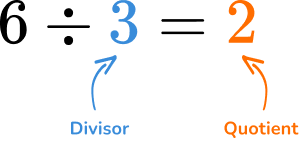
Here, the divisor is \bf{3} as we are dividing 6 by 3 to get a quotient of 2.
The divisor will always be a prime number for these questions and if the quotient is a prime number, we have found the full decomposition.
What are prime factors?
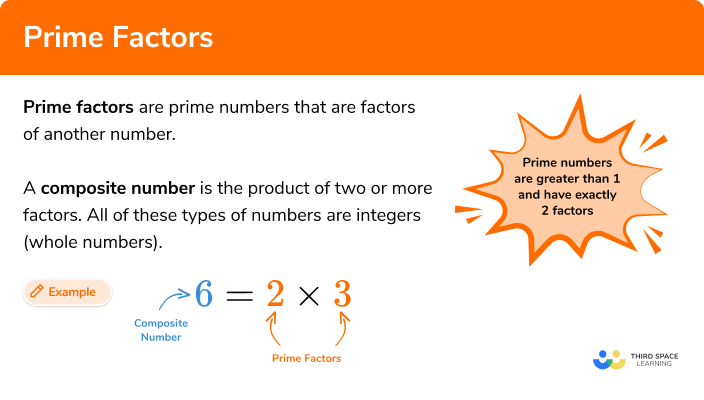
Common Core State Standards
How does this relate to 6th grade math?
- Grade 6 – The Number System (6.NS.2)
Fluently divide multi-digit numbers using the standard algorithm.
- Grade 6 – Expressions and Equations (6.EE.1)
Write and evaluate numerical expressions involving whole-number exponents.
Product of prime factors
Any positive integer can be written as a product of its prime factors. This means that we can take any positive number and write it as a series of prime numbers being multiplied.
For example,
6 is a product of 2 and 3, so can be written as 2\times{3}=6
9 is a product of 3 and 3, so can be written as 3\times{3}=9
We can use a process called prime factorization using prime factor trees in order to work out the product of prime factors.
For example,
Write 36 as a product of prime factors.
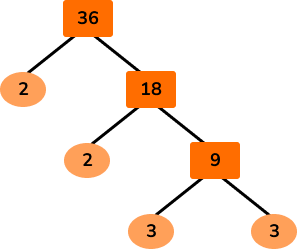
So,
36=2\times{2}\times{3}\times{3}This can also be written using exponents.
36=2^{2}\times3^{2}Let’s look at another example!
Write 54 as a product of prime factors.
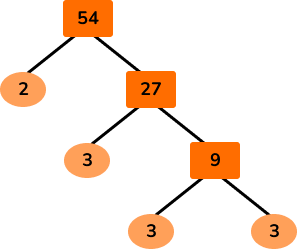
So,
54=2\times{3}\times{3}\times{3}Writing using exponents,
54=2\times3^{3}Divisibility rules
When finding distinct prime factors it is useful to use the divisibility rules.
\hspace{2.9cm} Divisibility Rules!
\hspace{2.3cm} A number is divisible by…….
| 2 | if the last digit is even or zero | |
| 3 | if the sum of the digits is divisible by three | |
| 4 | if the last two digits are divisible by four | |
| 5 | if the last digit is zero or five | |
| 6 | if the number is divisible by both two and three | |
| 8 | if the last three digits are divisible by eight | |
| 9 | if the sum of the digits is divisible by nine | |
| 10 | if the last digit is zero |
How to find prime factors of a composite number
In order to find prime factors of a composite number:
- Divide the composite number by a suitable prime number.
- Divide the quotient by another suitable prime number.
- Continue until the final quotient is a prime number, then state the solution.
![[FREE] Prime Factors Worksheet (Grades 6)](https://thirdspacelearning.com/wp-content/uploads/2023/11/Prime-factors-worksheet-listing-image.png)
[FREE] Prime Factors Worksheet (Grades 6)
![[FREE] Prime Factors Worksheet (Grades 6)](https://thirdspacelearning.com/wp-content/uploads/2023/11/Prime-factors-worksheet-listing-image.png)
Use this worksheet to check your grade 6 students’ understanding of prime factors. 15 questions with answers to identify areas of strength and support!
DOWNLOAD FREE![[FREE] Prime Factors Worksheet (Grades 6)](https://thirdspacelearning.com/wp-content/uploads/2023/11/Prime-factors-worksheet-listing-image.png)
[FREE] Prime Factors Worksheet (Grades 6)
![[FREE] Prime Factors Worksheet (Grades 6)](https://thirdspacelearning.com/wp-content/uploads/2023/11/Prime-factors-worksheet-listing-image.png)
Use this worksheet to check your grade 6 students’ understanding of prime factors. 15 questions with answers to identify areas of strength and support!
DOWNLOAD FREEPrime factors examples
Example 1: composite number <20
What are the prime factors of 18?
- Divide the composite number by a suitable prime number.
As 18 is an even number, we can divide 18 by 2.
18\div{2}=9The first prime factor of 18 is 2.
9 is not a prime number so we continue to Step 2.
2Divide the quotient by another suitable prime number.
9 is a multiple of 3 and so we can divide 9 by 3.
9\div{3}=3The second prime factor is 3.
3 is a prime number so the third prime factor is 3.
3Continue until the final quotient is a prime number, then state the solution.
As factors are multiplied together to achieve the composite number, we can say
18=2\times{3}\times{3}(or in exponent form)
18=2\times3^{2}.The final solution is therefore
18=2\times3^{2}.Example 2: composite number <50
Show that 42=2\times{3}\times{7}.
Divide the composite number by a suitable prime number.
As 42 is an even number, we can divide 42 by 2.
42\div{2}=21
The first prime factor of 42 is 2.
21 is not a prime number so we continue to Step 2.
Divide the quotient by another suitable prime number.
21 is a multiple of 3 and so we can divide 21 by 3.
21\div{3}=7
The second prime factor is 3.
7 is a prime number so the third prime factor is 7.
Continue until the final quotient is a prime number, then state the solution.
As factors are multiplied together to achieve the composite number, we can say
42=2\times{3}\times{7}
An exponent form does not occur for this example as there are no repeated factors that we can simplify.
The final solution is therefore
42=2\times{3}\times{7}.
Example 3: composite number <100
Express 75 as a product of prime factors. Write your answer in index form.
Divide the composite number by a suitable prime number.
As 75 ends in a 5, we can divide 75 by 5.
75\div{5}=15
The first prime factor of 75 is 5.
15 is not a prime number so we continue to Step 2.
Divide the quotient by another suitable prime number.
15 also ends in a 5 and so we can divide 15 by 5.
15\div{5}=3
The second prime factor is 5.
3 is a prime number so the third prime factor is 3.
Continue until the final quotient is a prime number, then state the solution.
As factors are multiplied together to achieve the composite number, we can say
75=3\times{5}\times{5}
75=3\times5^{2}
The final solution in index form is therefore
75=3\times5^{2}.
Example 4: composite number <500
Express 462 as a product of prime factors.
Divide the composite number by a suitable prime number.
As 462 is an even number, we can divide 462 by 2.
462\div{2}=231
The first prime factor of 462 is 2.
231 is not a prime number so we continue to Step 2.
Divide the quotient by another suitable prime number.
The sum of the digits of 231 \; (2+3+1)=6 which is a multiple of 3 and so we can divide 231 by 3.
231\div{3}=77
The second prime factor is 3.
77 is not a prime number so we need to continue to divide by prime numbers until the final quotient is prime.
Continue until the final quotient is a prime number, then state the solution.
As 77 is a multiple of 7, we can divide 77 by 7.
77\div{7}=11
The third prime factor is 7.
11 is a prime number so the fourth prime factor is 11.
As factors are multiplied together to achieve the composite number, we can say
462=2\times{3}\times{7}\times{11}
The final solution in index form is therefore
462=2\times{3}\times{7}\times{11}.
Example 5: composite number <1000
Show that 900 is a square number.
Divide the composite number by a suitable prime number.
As the sum of the digits of 900 \; (9+0+0)=9, we can divide 900 by 3.
900\div{3}=300
The first prime factor of 900 is 3.
300 is not a prime number so we continue to Step 2.
Divide the quotient by another suitable prime number.
The sum of the digits of 300 \; (3+0+0)=3 which is a multiple of 3 and so we can divide 300 by 3.
300\div{3}=100
The second prime factor is 3.
100 is not a prime number so we need to continue to divide by prime numbers until the final quotient is prime.
Continue until the final quotient is a prime number, then state the solution.
As 100 is an even number, we can divide 100 by 2.
100\div{2}=50
The third prime factor is 2.
50 is an even number so we can divide 50 by 2.
50\div{2}=25
The fourth prime factor is 2.
25 ends in a 5 so we can divide 25 by 5.
25\div{5}=5
The final two prime factors are 5 and 5.
As factors are multiplied together to achieve the composite number, we can say
900=2\times2\times3\times3\times5\times5
900=(2\times3\times5)\times(2\times3\times5)
900=(2\times3\times5)^2
So 900 is a square number.
Example 6: simplifying fractions
Simplify \cfrac{104}{124} using prime factors.
Divide the numerator by a suitable prime number.
104 is an even number so we can divide it by 2.
104\div{2}=52
The first prime factor of 104 is 2.
52 is not a prime number.
Divide the quotient by another suitable prime number.
52 ends in an even number so it is divisible by 2.
52\div{2}=26
2 is another prime factor.
26 is not a prime number.
Continue until the final quotient is a prime number.
26 ends in an even number so it is divisible by 2.
26\div{2}=13
2 is another prime factor.
13 is also a prime factor.
Rewrite the numerator as prime factors multiplied together.
Do the same process for the denominator.
The last digit of 124 is even so it is divisible by 2.
124\div{2}=62
2 is a prime factor.
62 is not prime.
Continue until the final quotient is a prime number.
The last digit of 62 is even so it is divisible by 2.
62\div{2}=31
2 is another prime factor.
31 is a prime factor.
Rewrite the denominator as prime factors multiplied together.
Look for matching common prime factors in the numerator and the denominator.
Two of the 2’s in the numerator match with two of the 2’s in the denominator. We can simplify the fraction by crossing out the matching factors.

Rewrite the fraction by multiplying the factors together.
Teaching tips for finding prime factors
- Reinforce visual models to help students conceptualize the concept.
- Start by dividing the given number by the smallest prime number.
- Then using that same strategy, divide that quotient by the smallest prime number.
- Keep repeating the process, until the quotient becomes 1.
- Lastly, multiply all the prime factors together.
- Expose students to cryptography, the study of secret codes, which relies heavily on prime numbers.
Easy mistakes to make
- Listing factors instead of writing them as a product (multiplying)
Given example 1, the solution would be incorrectly written as 18=2,3,3 instead of 18=2\times{3}\times{3}. Factors are multiplied by one another and so the solution should contain the multiplication symbol.
- Thinking all odd numbers are prime numbers
- Thinking \bf{1} is a prime number
- Incorrect knowledge of prime numbers
It is easy to find a factor of a composite number and not specifically a prime factor. Take example 6 where we were dividing 900 by 3. A more obvious start could have been to divide by 9, however 9 is not a prime number. When we look at larger composite numbers, there is a much more clear and efficient method to express the prime factors of a number.
Relates lessons on factors and multiples
Practice prime factors questions
1. What is 16 as a product of its prime factors?




8\div{2}=4
4\div{2}=2
2 is prime so we have found the prime factors.
16=2\times{2}\times{2}\times{2}=2^{4}
2. Express 63 as a product of its prime factors.




21\div3=7
7 is prime.
63=3\times3\times7=3^{2}\times7
3. Express the number 246 as a product of prime factors.




123\div3=41
41 is prime.
246=2\times3\times41
4. Simplify the fraction using prime factors. \cfrac{198}{441}




Divide the numerator by a suitable prime number. Since 198 ends in an even number, divide it by 2.
198\div2=99
99 is not a prime number, so continue to divide until all the factors are prime.
The sum of the digits of 99 is divisible by 3.
99\div3=33
The sum of the digits of 33 is divisible by 3.
33\div3=11
Now do the same thing with the denominator. Divide the denominator by a suitable prime number. The sum of the digits of 441 is divisible by 3.
441\div3=147
The sum of the digits of 147 is divisible by 3.
147\div3=49
49 is a multiple of 7.
49\div7=7
Write the numerator and denominator as a product of prime numbers. Match the common prime factors that are the same in order to simplify.

Multiply the factors in the numerator together and the factors in the denominator together.
\cfrac{2 \times 11}{7 \times 7}=\cfrac{22}{49}
5. Which of the following does not show 36 as a product of its prime factors?



They all show 36 as a product of its prime factors

Although 2^{2}\times9=36, 9 is not a prime number.
6. 720 can be expressed in the form 2^{a}\times3^{b}\times{c}
What are the values of a,b and c?




360 \div 2 =180
180\div2=90
90\div2=45
45\div3=15
15\div3=5
5 is prime.
720=2^{4}\times3^{2}\times 5
a=4, \; b=2, \; c=5
Prime factors FAQs
No, 1 is not a prime number because in order for a number to be prime it must be greater than 1. Also, prime numbers have exactly 2 factors and 1 only has one factor.
Yes, a composite number can have the same prime factors more than once.
For example, 8=2 \times2\times2 .
Most prime factors are odd, but not all odd numbers are prime. For example 2 is a prime number and it’s even. 9 is an odd number and it’s not prime.
The factor tree method is a strategy for finding the prime factorization of a number.
Computer coders use prime factorization of numbers to code.
It helps us to break down large numbers.
The next lessons are
Still stuck?
At Third Space Learning, we specialize in helping teachers and school leaders to provide personalized math support for more of their students through high-quality, online one-on-one math tutoring delivered by subject experts.
Each week, our tutors support thousands of students who are at risk of not meeting their grade-level expectations, and help accelerate their progress and boost their confidence.

Find out how we can help your students achieve success with our math tutoring programs.
[FREE] Common Core Practice Tests (3rd to 8th Grade)
Prepare for math tests in your state with these 3rd Grade to 8th Grade practice assessments for Common Core and state equivalents.
Get your 6 multiple choice practice tests with detailed answers to support test prep, created by US math teachers for US math teachers!
